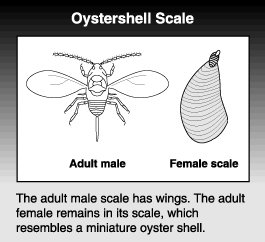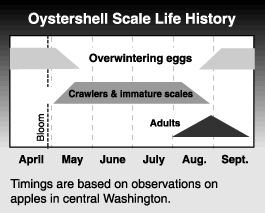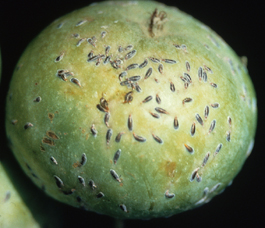by Stanley C. Hoyt, originally published 1993
Lepidosaphes ulmi (Linnaeus) (Homoptera:Diaspididae)
Oystershell scale, as the name implies, looks like a miniature oyster encrusted on a small limb or twig. It is of European origin but has been a common pest in the northwestern United States since 1850 and has since spread throughout the United States.
It infests trees of all sizes and ages and can kill young trees. However, it thrives on neglected trees and has rarely been an orchard pest. It lives primarily on bark but can affect fruit also.
Hosts
Oystershell scale infests apple and a large number of other fruit, shade and ornamental trees and shrubs.
Life stages
Egg
The egg is oval and pearly white.

Crawler
The newly hatched crawler of either sex is pale yellow in color and has six legs. It resembles a San Jose scale crawler. After a few days it sheds its skin and loses its legs and antennae, and begins to form the waxy scale coating. After the second molt, the male develops wings. The female continues to grow in the same globular form and secretes a new, larger scale at each molt.
Adult
The adult scale resembles a miniature oyster shell. The female scale is shiny, light to dark grayish brown, with parallel ridges across, and is from 1/16 to 1/8 inch (1.5 to 3 mm) long. The male is much smaller and has wings.
Life history
 The insect has one generation per year in the Northwest.It passes the winter in the egg stage under the scale of the mother. There can be from 40 to 100 eggs under one scale.Crawlers emerge from the scale in May and June. They can crawl some distance before settling down on the bark. They then insert their long mouthparts into the host and secrete a waxy covering. Females never move again, but the males, which have wings, eventually emerge from their coverings and mate. Females continue to grow in the same form and mature in August or September. As eggs are laid, the body of the mother gradually shrinks into the smaller end of the scale and the eggs occupy the rest of the space. The female dies after the last eggs are laid.
The insect has one generation per year in the Northwest.It passes the winter in the egg stage under the scale of the mother. There can be from 40 to 100 eggs under one scale.Crawlers emerge from the scale in May and June. They can crawl some distance before settling down on the bark. They then insert their long mouthparts into the host and secrete a waxy covering. Females never move again, but the males, which have wings, eventually emerge from their coverings and mate. Females continue to grow in the same form and mature in August or September. As eggs are laid, the body of the mother gradually shrinks into the smaller end of the scale and the eggs occupy the rest of the space. The female dies after the last eggs are laid.
Damage

Heavy oystershell scale populations on limbs and twigs weaken trees, but this damage is seldom seen in commercial orchards. Crawlers may settle on bark or fruit.
Monitoring
Look for scale on fruit and branches.
Biological control
Several predators feed on the scales but are rarely able to control them. Larvae of several parasites attack the eggs, and some birds also feed on scales.
Management
This pest can be controlled with delayed-dormant sprays of oil or oil with an organophosphate insecticide. Oystershell scales are difficult to target with insecticides, as they spend almost 75% of their lives as eggs protected by the scale. The insect is most vulnerable in June when newly hatched young are crawling about. Generally, pesticides used in commercial orchards prevent the build-up of this pest.
